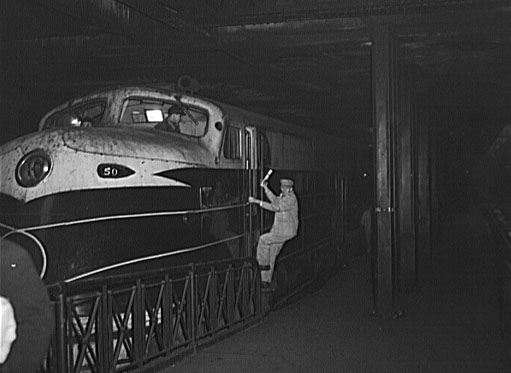- EMD EA/EB
Infobox Locomotive
name=EMD EA/EB
powertype=Diesel-electric
gauge=RailGauge|ussg

caption=B&O EA 56 atChicago, Illinois , February 1943
builddate=1937–1938
builder=General Motors Electro-Motive Division (EMD)
railroad=Baltimore and Ohio Railroad
poweroutput=convert|1800|hp|abbr=on|lk=on
enginetype=Winton 201-A, 2 off
aarwheels=A1A-A1A
totalproduction=6A unit s, 6B unit s
roadnumber=51–56 (A units), 51X–56X (B units)
disposition=number 51 on static display at theBaltimore and Ohio Railroad Museum The EMD EA/EB was an earlypassenger train -haulingdiesel locomotive built in 1937-1938 by General Motors Electro-Motive Division ofLa Grange, Illinois for theBaltimore and Ohio Railroad . [cite book
author=Pinkepank, Jerry A.
title=The Second Diesel Spotter's Guide
publisher=Kalmbach Publishing Co., Milwaukee, WI
year=1973
id=ISBN 0-89024-026-4] They were the first model in a long line of passenger diesels of similar design known asEMD E-unit s. Each locomotive unit developed convert|1800|hp from two 900 hp Winton 201-Adiesel engine s, driving the wheels through an electric transmission—the generator driven by each engine provided current fortraction motor s. The locomotives were of A1A-A1Awheel arrangement —two three-axle trucks of which only the outer two axles were powered. Six two-unit 3600 hp locomotives were produced, each consisting of a lead cab-equipped EAA unit and a cabless booster EBB unit . They were numbered 51 through 56; the A units bore the bare number and the B units the number followed by 'X'.Trains hauled
The six locomotives hauled some of the major named trains of the B&O; the "Royal Blue", the "Capitol Limited", the "
National Limited ", and others. These trains werestreamliner s in appearance, but they were built largely of refurbished heavyweight passenger cars rebuilt with smooth sides, smooth rooflines, air conditioning, new interiors and modern appointments.Significance and influence
The EA/EB—along with the more-or-less simultaneous E1 for the
Atchison, Topeka and Santa Fe Railway and the E2 for theUnion Pacific Railroad ,Chicago and North Western Railway andSouthern Pacific Railroad —represented an important step in the evolution of the passenger diesel locomotive. While the EA, E1 and E2 were each built for a specific railroad, they were largely identical mechanically and were a step further away from the custom-built, integratedstreamliner and towards mass-produced passenger locomotives—a step achieved with the E3, E4, E5, and E6, EMD's next models. These locomotives are definitely related in an evolutionary manner with all EMD's future passenger models.Styling
The EA/EB and E1 featured largely identical and innovative styling showing the influence of the Electro-Motive Corporation's new buyer General Motors. While mechanically they had much in common with previous, experimental EMC locomotives, GM understood the importance of looking new and exciting, not merely being technically innovative. This basic "slant nose" style was continued in the subsequent E3, E4, E5 and E6 models, while a more "bulldog nose" style was tried in the E2 and a style somewhere in between was used for the E7, E8 and E9, as well as the freight diesel
cab unit s. It could fairly be said that the overall styling influenced passenger locomotives around the world.Its initial design was protected under US Patent D106,918. [US patent reference
number = D106918
y = 1937
m = 11
d = 09
title = Design for a Locomotive Body
inventor =Harold L. Hamilton ,Richard M. Dilworth ,Martin P Blomberg ,Leland A. Knickerbocker , andChris J. Klein ]Surviving
The first EA, #51, survives as a static exhibit at the
Baltimore and Ohio Railroad Museum inBaltimore, Maryland .References
Wikimedia Foundation. 2010.
